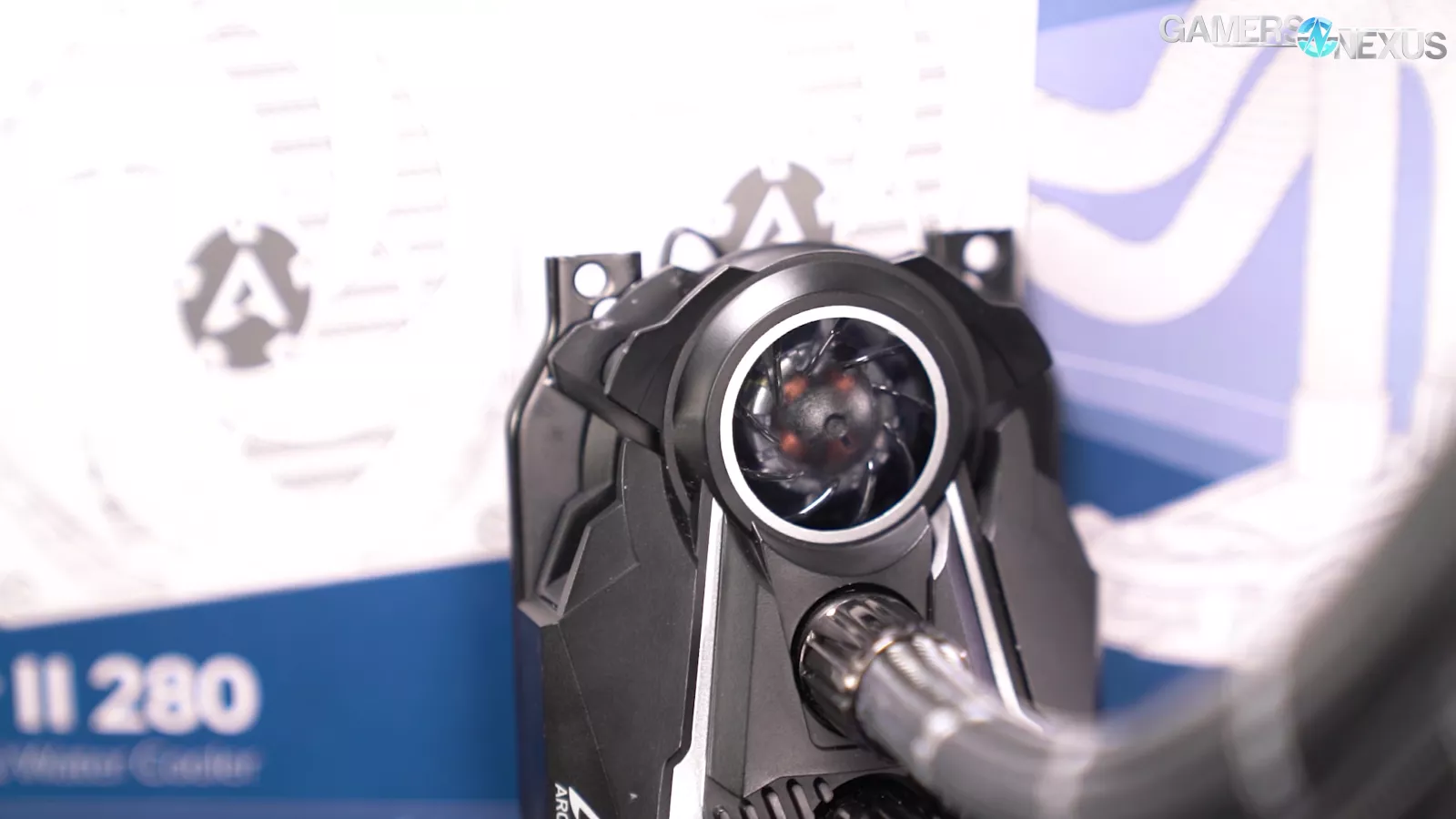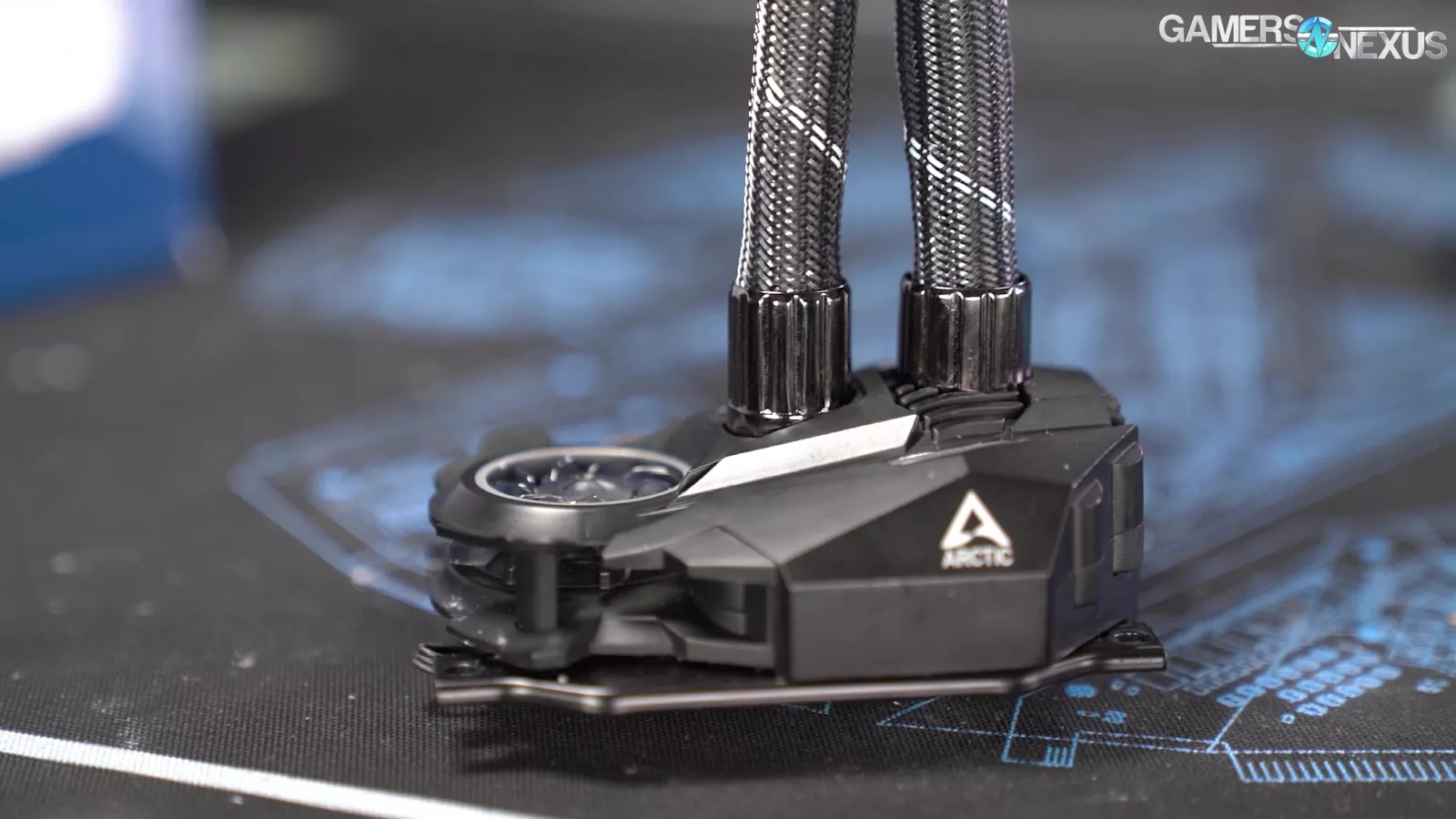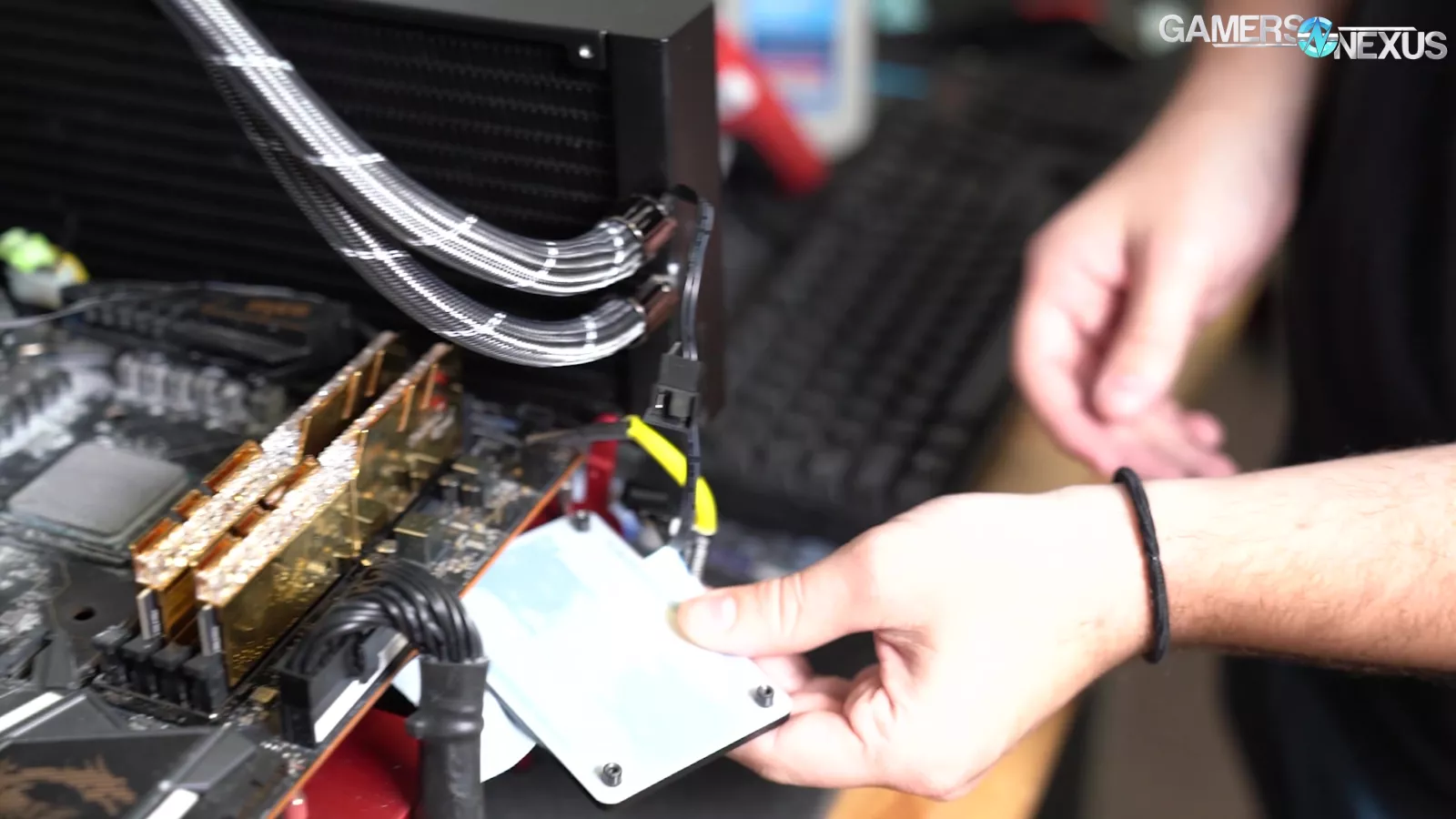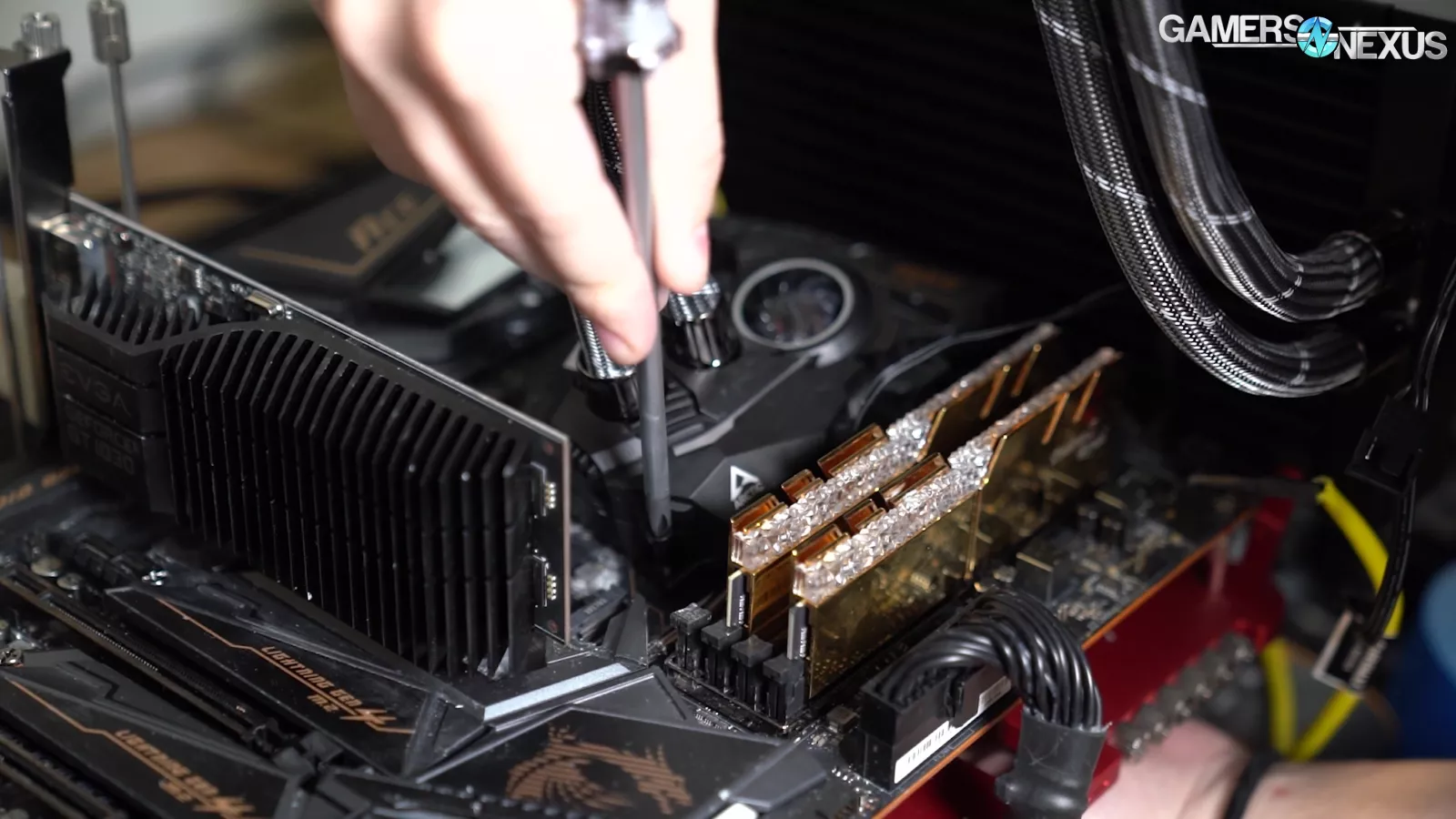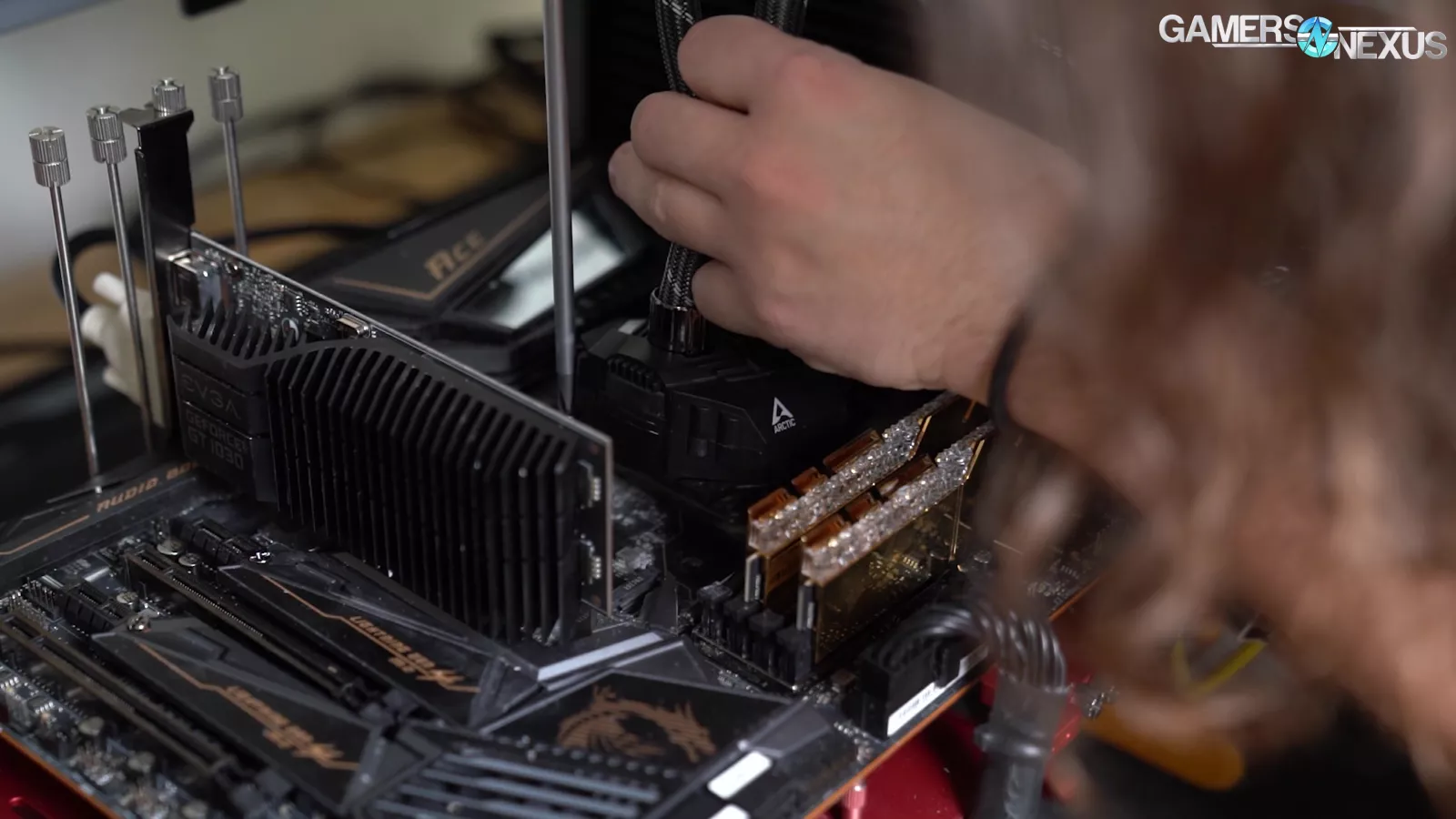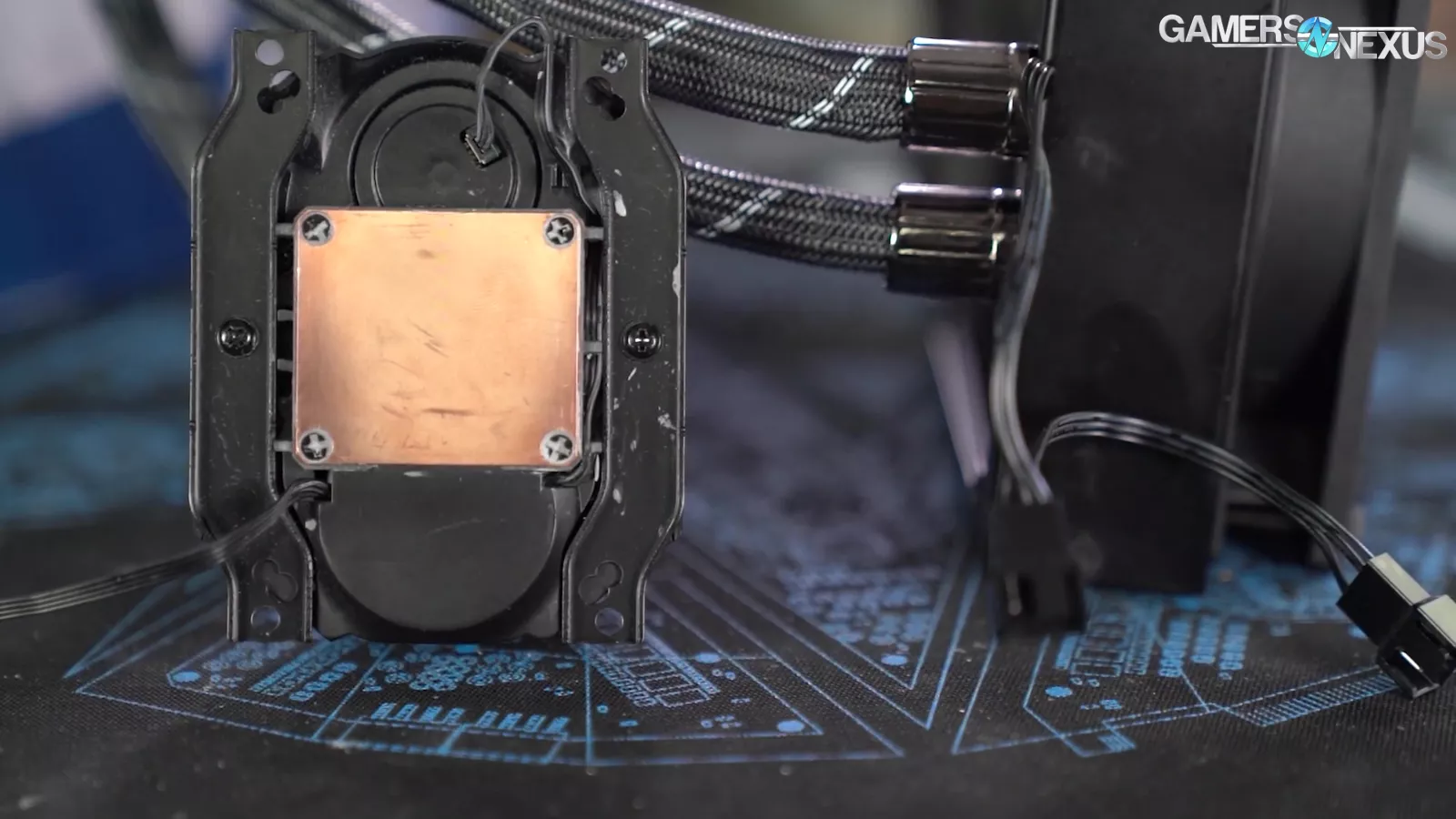
All killer, no filler: best in class, blacked out CLC at an excellent price.
The Highlights
- CLC in 240mm, 280mm, 360mm, and 420mm sizes
- Mounting hardware could be better on AMD
- High performing CLC at an extremely competitive price with a coldplate housing-mounted VRM fan
- Original MSRP: $95
- Release Date: September 25, 2019
Table of Contents
- AutoTOC

Important Background Information
Today’s review has been the most-requested review from our commenters for about 6 months now, and it’s not even a piece of silicon. The Arctic Liquid Freezer II series has gotten heavy community interest because of high reported performance in the enthusiast forum user base. We wanted to look at it with our new testing methodology that we started developing in the last half of 2019 (when the Liquid Freezer came out) to see how the Liquid Freezer performs against incumbents, including the NZXT Kraken X62 (similar to the X63 we reviewed), the Noctua NH-D15, and a growing list of others. The Liquid Freezer’s biggest marketing point, currently wedged in between being a gimmick and a useful feature, is its included VRM fan on the coldplate housing. Our review includes benchmarks of VRM thermal performance with and without this fan, tested in A/B fashion, and also tests surface levelness, CPU core thermals on the 3950X and 3800X at 200W and 123W, noise tests, and time-to-max temperature.
As with most liquid coolers there’s a lot of different radiator sizes for this, but we have the 280mm that we’re reviewing today. We’ve done dozens of liquid cooler reviews over the past three years or so, and we’ve just booted up our new test bench that includes air cooler reviews. Critically, our new test bench bakes in the new VRM thermal testing. We've been slowly collecting this information and we can finally look at whether this included 40mm VRM fan on top of the pump housing actually does anything or if it’s a complete – as opposed to partial – gimmick.
Editor's note: This was originally published on April 16, 2020 as a video. This content has been adapted to written format for this article and is unchanged from the original publication.
Credits
Editorial, testing
Steve Burke
video
keegan gallick
web Editing
jack reitman
The pump is part of the block on the Liquid Freezer - you can actually see the part on the bottom of the pump where the impeller is located. We also have a separate tear-down for this. The VRM fan plugs in separately to the underside of the block. You cannot control the VRM fan through BIOS, but it’s also fairly quiet – you can’t hear it over the rest of the system noise. You can disconnect the fan if you want to, which is how we performed our “AB” test for VRM thermals.
Other key features for the Liquid Freezer include the fact that they’ve shoved the cables inside the tube sleeving, which is something Fractal did a couple of years ago on its subpar Celsius series. There are no fancy RGB LEDs to speak of, but that also benefits the price. The reason this one is so interesting to a lot of people is because reportedly it’s a very good performer, but it’s also $95 for the 280mm version. At that point you’re competing with the EVGA CLC 280, which was the previous best value 280mm CLC you could get, at close to $120 for a while. Something like an NZXT Kraken series X52, X63, or X62 will cost $150-$160 for basically a bunch of LEDs, because otherwise the thermal performance from one 280mm CLC to the next (especially if they’re all Asetek) is not all that different. So the delta in price alone is massive.
The next big question outside of thermal performance is endurance, which we can’t obviously test within a review cycle, so that’s going to be something we’ll have to revisit if something goes wrong in the future. We can speak to the modern Asetek coolers lasting generally a very long time, such as the NZXT units we’ve had – eight or so X61 and X62s in deployment since they came out – have a warranty of six years. Extreme permeation is expected to set in around the six year mark at which point you could maybe refill it if you had to, but depending on the climate you’re in, the use case, and how intensive it is, you may have already had extreme permeation set in.
We don’t know where that is going to hit with the Liquid Freezer, but if it follows the design philosophy of most coolers then it should be around the same period, but it has a much shorter warranty (two years, depending on region).
Before we get into the thermal numbers, we revised our testing methodology - we have a video and article version available. It’s the same content, so pick whichever you prefer and catch up on how we do this test. We are not going to recap the methodology in full here. When we do noise-normalized testing, we set the product as it is to the same noise level as every other product (to some fixed noise level that we’ve chosen at a 20-inch distance from the product), but we don’t change the fans. So, normalizing for noise does not mean normalizing for fans – we use the fans as they are mounted on the product.
CPU Cooler Test Bench
| Part | Component | Provided By |
| CPU | AMD Ryzen 5 3600 - Used for lower ~68W heat loads for small coolers. AMD Ryzen 7 3800X (2 chiplets active) - Used in all cooler benchmarks. AMD Ryzen 9 3950X (3 chiplets active) - Used for higher heat loads to show scaling on big coolers. | AMD |
| Motherboard | MSI X570 MEG ACE | GN Purchase |
| RAM | GSkill Trident Z Royal DDR4-3600 CL16 | GSkill |
| GPU | EVGA NVIDIA GeForce GT 1030 SC (passive cooler, second slot down) | GN Purchase |
| PSU | EVGA 1600W P2 | EVGA |
| OS | Windows 10 | GN Purchase |
35dBA Noise Normalized on 3950X
Our next chart will be of the VRM fan performance, but we’ll start with the one everyone is used to. For this one, we’re using a 200W workload with the AMD R9 3950X, which is more useful for stressing the differences in high-end coolers. This test is equalized to 35dBA in order to level the playing field so that coolers can’t just brute-force their way to the top, like the EVGA CLC 360 would do at its 60dBA baseline for noise at 100% speed.
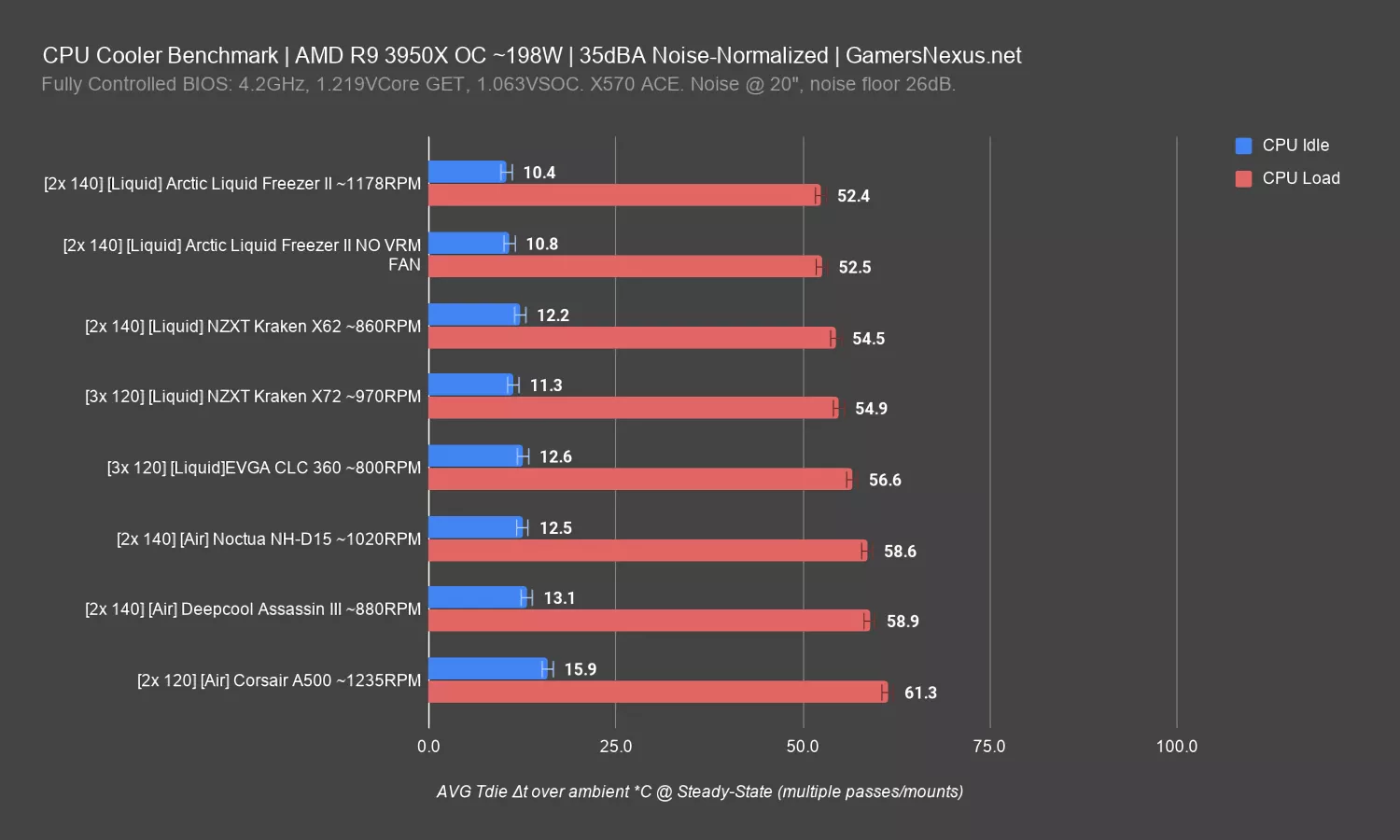
The Liquid Freezer II ends up as the top-performer on the bench when noise-normalized to 35dBA across the board. The Arctic Liquid Freezer results were benched six times each, with and without the VRM fan, and with 2 sets of re-mounts, plus additional tests of three to six times each for the 3800X and the 100% results. The deviation run-to-run across the board was under 1 degree, so consistency was good. The 52-degree load result has the Liquid Freezer II about 2 degrees cooler than the X62 at the same noise level. It’s outdoing the NZXT X72 and EVGA CLC 360, which both struggle at these lower noise levels because they have too many fans at too small of a size, and so they lose pressure, which they need to push air through the radiator effectively. The NH-D15 is outdone by about 6 degrees Celsius by the Liquid Freezer, which is enough to allow some potential for additional overclocking headroom.
At the $95 price, Arctic II 280mm solution is kicking everyone’s ass, especially the NZXT Kraken. The NZXT Kraken X62 isn’t anywhere close in pricing, and although the newer X63 is $10 cheaper at $150, its performance isn’t much different, and the price is massively hiked over the Arctic solution. If you’re only going for function and cooling (outside of reliability which is yet untested) the Arctic is doing better. The Corsair A500 air cooler gets buried even deeper than it was at launch. The NH-D15 or Assassin III still have the same uses they always had, mostly related to those discussed in the air vs. liquid content (like reliability and overall simplicity). Other CLCs will mostly come down to LEDs or warranties. The Liquid Freezer isn’t yet tried for reliability, and that’s a huge component of coolers that we have no way of accelerating for a review.
VRM Airflow (Linear Feet Per Minute)
The next test will be for the VRM fan. For this, we’re going to start with an overlay demonstrating the linear feet per minute flow, often called FPM or LPM, as measured with a hotwire anemometer at the edge of the chassis for the cooler. The measurement is taken at an angle toward the VRM heatsink and the chassis is defined as the pump block housing typically (where the coldplate is). We measured at a few points and under a few conditions.
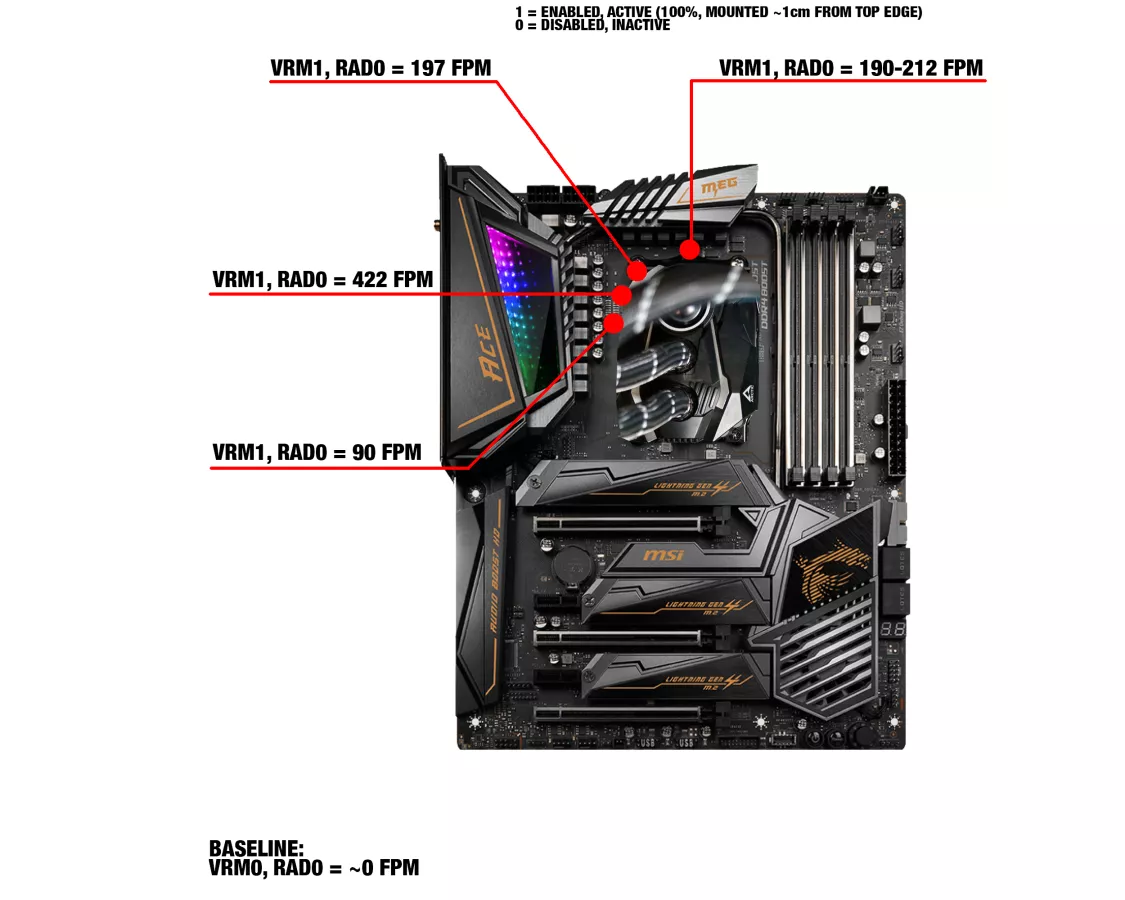
For this image, the VRM fan was enabled and the radiator fans were disabled, as was room AC. The FPM baseline was 0 – meaning air was almost literally not moving in the room (we like to simulate a tomb where we work). North of the socket, aligned with the top-center of the cooler and center of the fan opening, the FPM measured between 190 and 212. It fluctuates as usual with fine air movements. The northwest corner of the cooler, measured at the top-left screw of the mount, measured at about 197FPM toward the VRM. The upper-left side measured at 422FPM, as we seemed to find the exact angle at which air exits the chassis the fastest and hits the VRM. The mid-left side fell to 96FPM, as we were at the edge of the chassis opening.
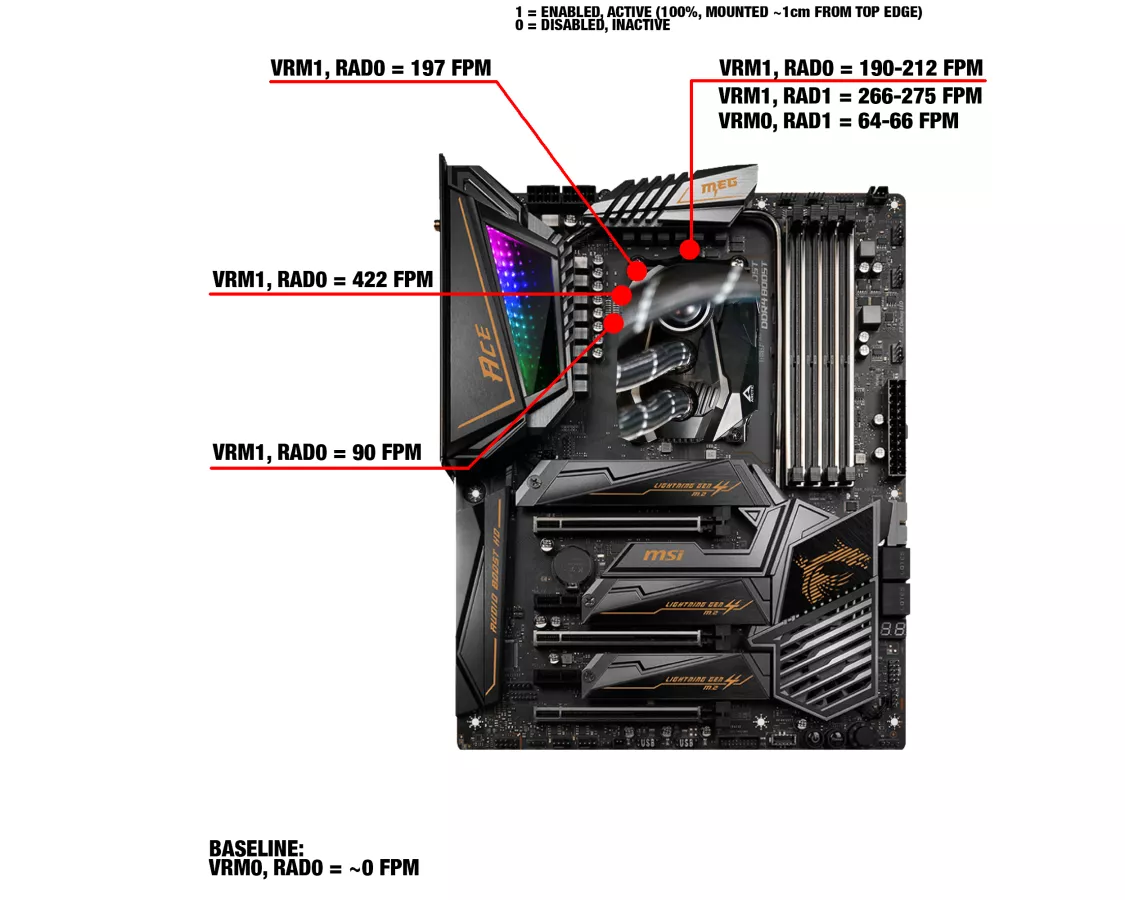
The next measurement is at 100% radiator fan speed, with the radiator mounted approximately 1cm away from the edge of the board. This is a similar distance to what you’d find in a lot of cases, with fans blowing toward the motherboard. In this configuration, linear feet per minute flow is about 266-275. With the radiator fans blowing and the VRM fan off, measured on the other side of that solid VRM heatsink, FPM predictably drops to 64-66.
This is obviously still plenty high on the other side of the heatsink (the side towards the fans) – north of 400FPM, actually – so it’s not like all cooling has vanished. That said, if you front-mount the radiator, having the VRM fan on the block could be somewhat beneficial in scenarios where an overly hot configuration is used and you have no fans at all in the top or rear of the case. However, most people should have at least one fan in one of those positions.
VRM Benchmark v. MOSFET Thermals
Before moving to the VRM thermal chart, a few important points that we need to go over: first, this is all relative, so our measurement points aren’t designed to test the motherboard, but rather to test the cooling capabilities of the CPU cooler on top of it. We’re taking VRM measurements at points that will work better for testing cooler impact, since we don’t care about comparative VRM performance from one board to the next and we’re not looking to see if the VRM is any good.
Second, we’ll show the numbers with the radiator mounted to the side of the bench. That’s how we tested all the liquid coolers so far, as it is more similar to a top-mounted radiator in a case. This means there’s always airflow over the VRM heatsink in all the CLC tests, whereas testing it on the table, away from the VRM, would paint a picture of Arctic’s VRM fan having a higher relative impact since you’d be taking away all other cooling otherwise. We have these numbers too, but let’s focus on 3950X OC numbers at 35dBA radiator fan speed first, with the Arctic VRM fan at 100%. The test is also tough to standardize since every motherboard will have different heatsinks and positioning, so although you can mostly extrapolate out a hierarchy, it’s not perfectly comparable to every configuration. And again, please also remember that case configuration has the greatest impact on VRM thermal performance outside of the VRM design and cooling solution. What we’re saying is that this test will create an objective hierarchy, but that in all reality, a couple degrees here-and-there in a controlled test won’t really matter much when considering the VRM is unlikely to melt itself in the majority of instances anyway.

Here’s the chart.
The Arctic Liquid Freezer’s VRM fan is both a gimmick and not a gimmick. It’s not a gimmick because it actually works: the top result is with the VRM fan on, measuring at 34.7, 38.3, and 28.4 degrees over ambient for our three measurement points; reminder that these are averages of averages, a couple thousand cells of data at that point. The Liquid Freezer with the VRM fan off loses a few ranks, consistent across all 12 total test passes for this one chart (and we have about 24 test passes for the other 3 configurations we ran). The result falls from 28.4 for VRM2 to 33.6, a change of about 5 degrees Celsius, and from 38.3 to about 42.6 on VRM1. So yes, it works and is therefore not a complete gimmick.
At the same time, it’s not really relevant. It doesn’t hurt to be cooler of course, but this one feature shouldn’t be the tipping point between you buying the product and not. If it’s between this and another cooler, and you mostly have your heart set on the other one for visual or compatibility or warranty reasons, don’t let the VRM alone sway the decision. If your board is going to run so hot that you need an extra 5-degree reduction, it’s probably time to find another board or case solution altogether.
That said, this does reduce temperature and it does work, and in cases that are really hot and closed-off, with a 3950X or higher-power chip, with overclocking, and with a VRM which is undercooled and overheated, this would be a value add. We just don’t think that’s going to be a very common scenario for people spending that kind of money on a 3950X, and while it gets praise for doing a good job and chart-topping, we don’t think it should be the deciding factor in the purchase since an extra couple of degrees if it’s already that hot would mean you likely have bigger problems and it’s time to find more than just that solution.
Time-to-Max Temperature (Steady State)
This next chart is quick. This is our time to steady state at a noise-normalized 35dBA, or the time at which we reach equilibrium on the 3950X. Liquid coolers take longer to reach equilibrium than air coolers as a result of their water capacity that soaks rapid heat changes better. Big air coolers have well-marked advantages, mostly the install-and-forget benefit, but also reach steady state in a quicker time - just 90 with the thermal load that we are testing. Liquid coolers afford longer periods of low thermals for bursty workloads, which can also help with controlling or soaking fan speed changes with any kind of fan curve. That’s discussed in the previous video, but the Arctic cooler is the new item for this chart.
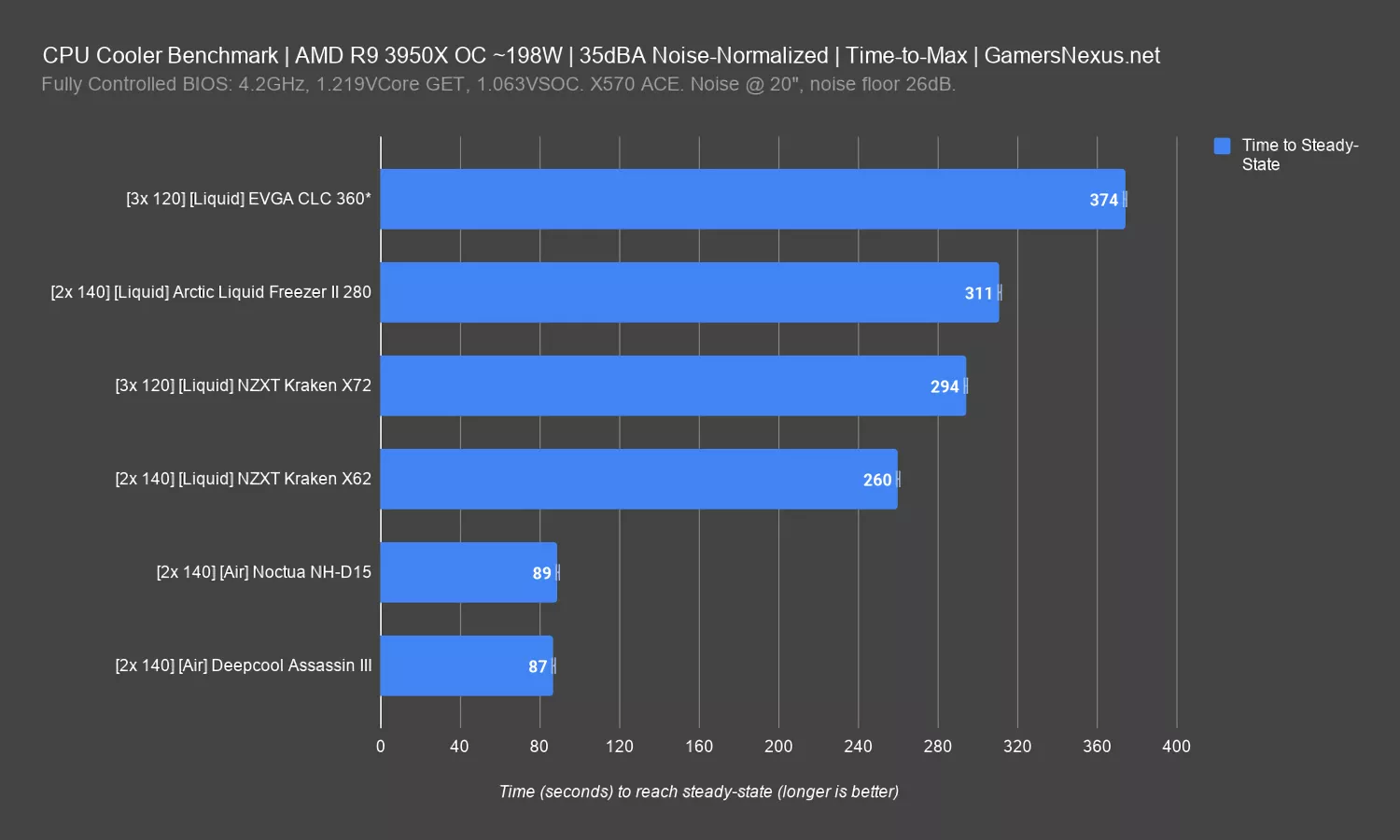
We found the Liquid Freezer II 280mm CLC reaching steady state in approximately 311 seconds, or about 5.2 minutes. That’s a longer period than the Kraken X62’s 260-second interval (4.3 minutes), which is one of our bench-toppers currently. The X72 and EVGA CLC 360 do poorly here, mostly because the noise requirement is low enough while the fans are small and plentiful enough that they struggle to reach the static pressure required to compete with the 280 CLCs. The CLC 360 takes the longest to reach steady state because it’s burning in this test, so it becomes a matter of the liquid temperature running higher on average than the Kraken or Arctic series. That’s why it has an asterisk next to it – the data isn’t directly comparable.
100% Fan Speed Test on 3950X
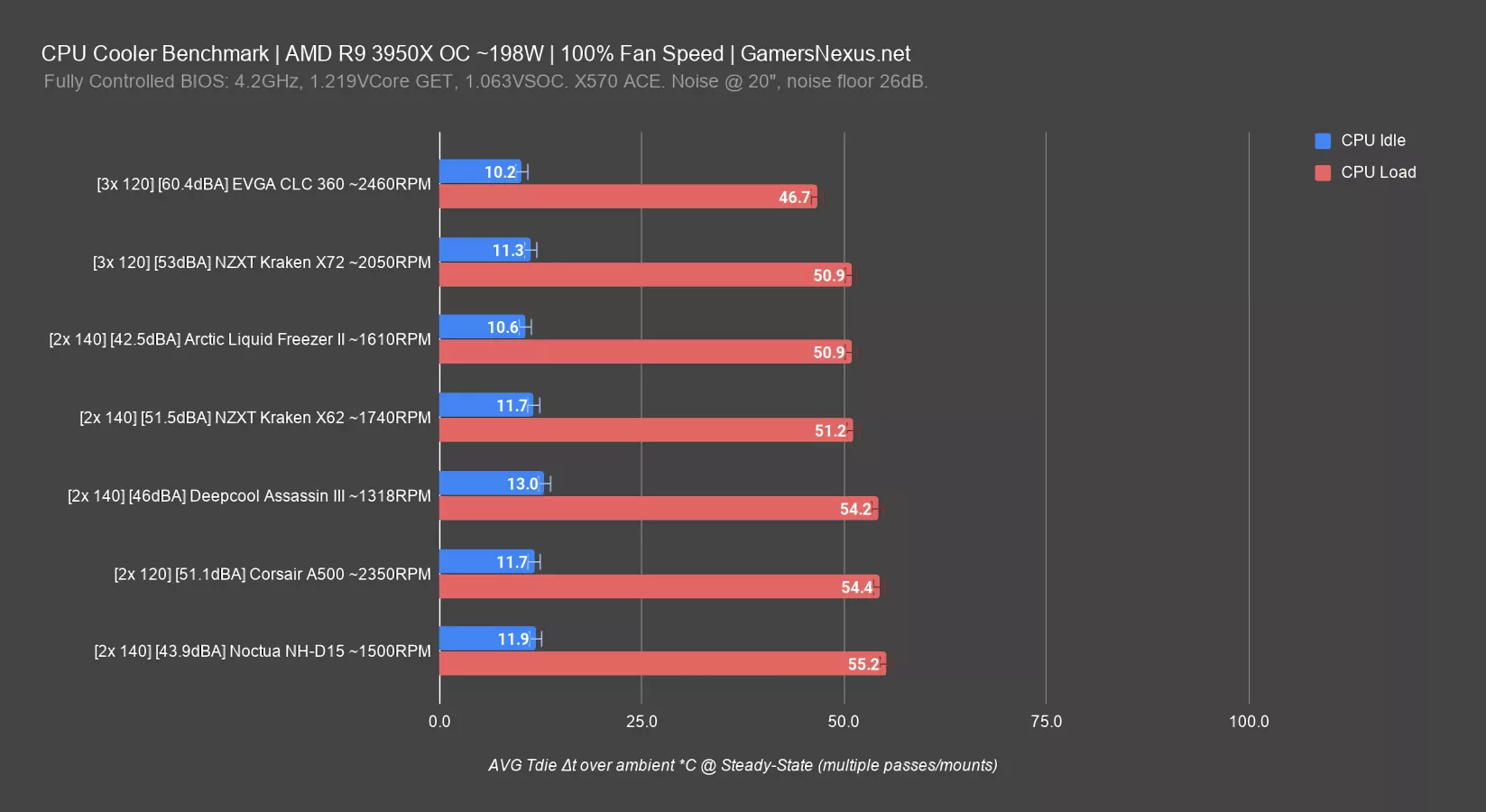
Our next chart continues with the 3950X 200W load, but allows all the coolers to run at 100% fan speed during the test. This doesn’t move the needle much for Arctic, which seems to top-out in its efficiency at around 1200RPM rather than its maximum 1600RPM. The results were +/-1C as usual, but our average ended up at 50.9 degrees over ambient. That’s not enough of a change, so there’s room to reduce noise level without much loss of overall performance.
At the 1610RPM speed, the Arctic cooler ran at 42.5dBA at the normal 20” distance. This puts it about equal in thermal performance to the NZXT Kraken X62 and X72, which run at 51-53dBA, or a perceived noise increase to the human ear between the Arctic and Kraken cooler of about 2x. Again, that’s perceived noise loudness to the human ear, not acoustic power, which is a different scale. Arctic’s solution is significantly quieter at the same performance. The EVGA CLC 360 shows that we’re not limited by our test bench (there is room to improve still), but also that jet engine levels of noise are needed to drive the temperature down further.

35dBA Noise-Normalized 3800X
Moving briefly to the 3800X, we have to issue a reminder that this CPU is tested with completely different voltage and overclock settings, not to mention the fact that it’s physically a different CPU in dies and as a CPU. This would be the same if we tested it with a different 3950X too - the IHS is different, the silicone adhesive is different, so these results are not directly comparable to the 3950X results. It’s just a lower power test to show you another look at things.
The 3800X was intended to be our standardized platform before we got to these higher-end coolers, the charts level-off a bit with the big air coolers and the liquid coolers as discussed in the two recent cooler videos we did. The reason they level off is because the heat load isn’t enough and the gap between coolers begins to shrink. These larger coolers do better at showing their differences once there’s a higher heat load that can stress the smaller coolers beyond what they’re really capable of. This is why the NH-U14S does so well relative to the large air coolers in this specific test.

For the Arctic Freezer at 35dBA, we see a 51-degree load temperature, putting the cooler just below the Kraken X62 while remaining significantly cheaper. Idle temperatures also plot the lowest for Arctic, not that this is particularly useful, and that’s partly because of the VRM fan slightly reducing heat in the area of the socket, which does end up affecting CPU temperature as well.
3800X Auto Frequency Results
For tests which leave the frequency to auto but control the voltage, we instead report on frequency rather than thermal outcome. Note that the best frequency doesn’t mean it’s the coolest – it becomes a touchier subject, since frequency jumps around to begin with, and because a better cooler means Precision Boost 2 will kick into higher frequency automatically, which creates more heat. This is not as reliable or simple of a metric, but so long as you have the error baked in, it’s okay.

For auto frequency and normalized to 35dBA, the Liquid Freezer II chart-tops with the 3800X at 4253.5MHz all-core average, followed closely by the big air coolers. The Noctua NH-D15, be quiet! Dark Rock 4, and DeepCool Assassin III are all within error and test variance, as is the Corsair A500. Gaining an extra 50MHz over a high-end air cooler is about the difference you can expect if you’re not planning to overclock - the X62 would be in here as well with the Arctic cooler.
It’s not like that’s going to equate an FPS advantage that’s noticeable to the human eye, and it’ll only help render times extremely marginally – we’re talking seconds on the hour, maybe up to half-a-minute on the hour. It’s not worth stressing about, but it’s another small benefit of having a better cooler.
Coldplate Levelness Benchmark
Our next test is for the levelness of the coldplate surface, measured with special precision instruments for testing that we debuted in our Corsair A500 review to show its biggest pitfalls. This testing helped illustrate where the A500 went wrong, and it was in the levelness of the coldplate, causing large gaps that required more TIM to fill than was reasonable for a $100 product.

This shows the delta in height, measured in microns, from a calibrated 0-point. The A500’s box plot shows the largest range, illustrating the chaotic levelness that hurt its performance so much, while the DeepCool Assassin III and original Wraith coolers have some of the best surface levelness. The Arctic Liquid Freezer II averaged about 8-10 microns depth from the 0-point, with minimums and maximums at 2 microns and 48 microns respectively. The Liquid Freezer II has a couple deep points in the coldplate, but is overall closer to smooth than unlevel.
Installation & Mounting
Our last point is on installation and mounting hardware. Coolers typically differentiate themselves by falling into one of two categories for ease-of-installation: you can either install it literally single-handedly or you need three hands, a forehead, and some tape to install it. Liquid coolers typically fall into the easier camp, and that’s because the mass on the socket isn’t as stressful for the board, so less meticulous, fine-tuned mounting hardware is required than with a massive heavy cooler. It’s easier to seat a couple of threaded screw caps onto a backplate to hold it all in place, and then drop the cooler down and install some more cap screws.
The Arctic Liquid Freezer is not one of those. It’s not the easiest we’ve worked with, but it’s not terrible. But basically you’ll want to install this flat on the table. If you can (without installing the radiator into the case first), ideally what you do is seat the AM4 (or Intel) backplate under the motherboard, put it flat on a table, and then socket it because you only have four screws for this. If the board is suspended in any way (test bench or case), you’ll need one hand to hold the plate, one hand to align the cooler housing, and a third hand (we typically grow them out of our stomach) to install the screws. Arctic has cut down on their mounting hardware as much as possible - it cuts down on cost and in theory is simpler. The only downside is that in the instance where the motherboard is already installed, then it becomes inconvenient.
However, you can grab some tape to hold the backplate in place for a bit, and then you’ll be fine. It is just annoying to do, but not a deal breaker in any way. You typically install a cooler once every couple of years, so you’ll rarely ever need to worry about it. There’s not a major point other than to say that we’d like to see Arctic consider moving to a system similar to Asetek or some of the other companies where it’s a backplate and then you have a threaded rod that holds it in place, and then you socket the cooler on that and put a cap screw on top.
For the fans, you’ll be working with small 2-3 inch fan cables attached to the fans, so you may want a cable extension if you are planning to run the cables to the motherboard. This is what we do because we like to control things directly through different headers so that we can fine-tune it. If you’re ok with it, you can connect to this splitter, but even this is kind of short and also you lose some of the control - the finer control that you get by going into the motherboard. We are normally hesitant to request that a company include extension cables in the box because if most people don’t use them, then it’s wasteful. Even if you don’t care about the e-waste aspect, you should care about the fact that your money is still going into it - it’s not free. However, if it is something most people are going to buy, then it does help to include it and brings the cost down to economies of scale.
Conclusion

At $95, the 280mm version of Arctic Liquid Freezer II kicks the ass of the other liquid coolers we’ve tested so far. The closest thing to this (which is not on this bench) would be the EVGA CLC 280 and they’re both stripped down for LEDs and are somewhere similar in price, but the Liquid Freezer II 280 is just a better product. We were surprised to see it do as well as it did, not because it should do poorly, but because at the price, you really don’t expect it to outperform something like a NZXT Kraken X63 or X62 in a way that is measurable and repeatable; not error or lost from run to run variation.
We ran this thing at least 12 times for one configuration and we ran multiple configurations, so it should have been at least 24 separate mounts, but probably closer to 36, and the results were reproducible every single time, so a very good product with a good price.
However, we can’t speak to the endurance of the cooler, which is something we always have to caution with liquid cooling products, but to be very clear the failure rate of liquid coolers overall is extremely low. It’s just that the ones that fail are catastrophic and can get a lot of coverage. You can learn all about that on our Air vs. Liquid cooler content where we break these aspects down.
The only thing you really have to consider is air instead of this because in terms of liquid, if you don’t care about the looks and you’re okay with just blackout and don’t need a bunch of LEDs and an infinity mirror, then this is the one we would buy for liquid at the price - it wins. With respect to air, the air coolers are close enough that you can still buy those if you prefer the install-and-forget-it nature or if you’re really paranoid about potential failure of a liquid cooler (which is not common, but is common enough where it is a consideration for a critical system).
That’s it for this one. Go to the GN Store or Patreon to help us out directly. We’ll see you next time.

